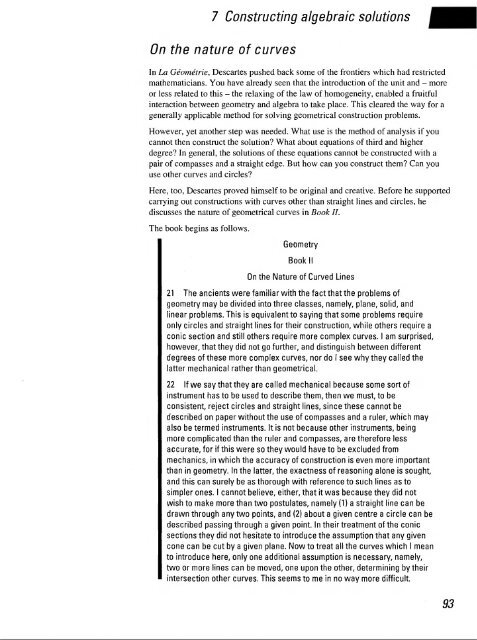history of mathematics - National STEM Centre
history of mathematics - National STEM Centre
history of mathematics - National STEM Centre
Create successful ePaper yourself
Turn your PDF publications into a flip-book with our unique Google optimized e-Paper software.
7 Constructing algebraic solutions<br />
On the nature <strong>of</strong> curves<br />
In La Geometric, Descartes pushed back some <strong>of</strong> the frontiers which had restricted<br />
mathematicians. You have already seen that the introduction <strong>of</strong> the unit and - more<br />
or less related to this - the relaxing <strong>of</strong> the law <strong>of</strong> homogeneity, enabled a fruitful<br />
interaction between geometry and algebra to take place. This cleared the way for a<br />
generally applicable method for solving geometrical construction problems.<br />
However, yet another step was needed. What use is the method <strong>of</strong> analysis if you<br />
cannot then construct the solution? What about equations <strong>of</strong> third and higher<br />
degree? In general, the solutions <strong>of</strong> these equations cannot be constructed with a<br />
pair <strong>of</strong> compasses and a straight edge. But how can you construct them? Can you<br />
use other curves and circles?<br />
Here, too, Descartes proved himself to be original and creative. Before he supported<br />
carrying out constructions with curves other than straight lines and circles, he<br />
discusses the nature <strong>of</strong> geometrical curves in Book II.<br />
The book begins as follows.<br />
Geometry<br />
Book II<br />
On the Nature <strong>of</strong> Curved Lines<br />
21 The ancients were familiar with the fact that the problems <strong>of</strong><br />
geometry may be divided into three classes, namely, plane, solid, and<br />
linear problems. This is equivalent to saying that some problems require<br />
only circles and straight lines for their construction, while others require a<br />
conic section and still others require more complex curves. I am surprised,<br />
however, that they did not go further, and distinguish between different<br />
degrees <strong>of</strong> these more complex curves, nor do I see why they called the<br />
latter mechanical rather than geometrical.<br />
22 If we say that they are called mechanical because some sort <strong>of</strong><br />
instrument has to be used to describe them, then we must, to be<br />
consistent, reject circles and straight lines, since these cannot be<br />
described on paper without the use <strong>of</strong> compasses and a ruler, which may<br />
also be termed instruments. It is not because other instruments, being<br />
more complicated than the ruler and compasses, are therefore less<br />
accurate, for if this were so they would have to be excluded from<br />
mechanics, in which the accuracy <strong>of</strong> construction is even more important<br />
than in geometry. In the latter, the exactness <strong>of</strong> reasoning alone is sought,<br />
and this can surely be as thorough with reference to such lines as to<br />
simpler ones. I cannot believe, either, that it was because they did not<br />
wish to make more than two postulates, namely (1) a straight line can be<br />
drawn through any two points, and (2) about a given centre a circle can be<br />
described passing through a given point. In their treatment <strong>of</strong> the conic<br />
sections they did not hesitate to introduce the assumption that any given<br />
cone can be cut by a given plane. Now to treat all the curves which I mean<br />
to introduce here, only one additional assumption is necessary, namely,<br />
two or more lines can be moved, one upon the other, determining by their<br />
intersection other curves. This seems to me in no way more difficult.<br />
93
















